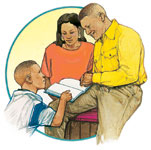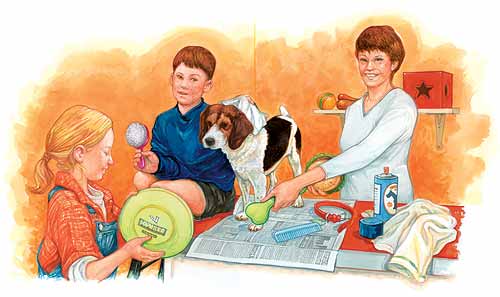
Helping Children Take Care of Pets
By Cynthia Wallace
Illustration by Joel Snyder
Teaching a child to be responsible for a living creature can be time-consuming and stressful, but the benefits for the youngster will last a lifetime.

Children often beg their parents to take a dog or cat into the household because it would be "fun" to have the animal around. In the best of circumstances, a child's pet experience can be much more than fun. A dog or cat, even a bird, hamster, or fish, can teach a child about unconditional acceptance, compassion, responsibility, communication, and more.
However, before you decide to allow your child to bring a pet into the home, be certain that you, the parent, can fulfill additional emotional demands. A family that's already burdened by other obligations—family members with special needs, money challenges, or existing pets—will have difficulty taking on the stress of teaching a child to care for a pet.
Choosing the right pet.
The experience begins with choosing the appropriate pet for your child. The pet should not have needs that exceed the child's maturity and ability to meet those needs. For instance, a 6-year-old cannot walk an 80-pound dog on a leash (and that's what a Labrador puppy will be at 10 months). And a preteen can't be expected to housebreak a puppy without a lot of assistance from parents.
Discuss the desired pet with your child before bringing it home, and consider as many aspects as possible: Does the child have allergies? What is the temperament of the proposed pet's species and breed? How much care will it require? Will the child give up leisure time to care for the pet?
It's also a good idea to observe the child interacting with the animal to help decide whether it would be a good fit for the youngster and home.
Taking responsibility.
When considering a new pet, carefully assess the amount of responsibility your child can handle. Child psychiatrist Dr. Judith Milner of Everett, Wash., cautions: "If you choose a pet that's above the child's level of capability, and the child has too much responsibility—more than the child can carry out—the child's going to feel like a failure. The parent's going to feel like a failure. And if they have to get rid of the pet, that's going to be a big disappointment."
The parent is a crucial partner for a child with a new pet. Dr. Milner advises parents: "If the child hasn't had prior responsibility, you need to be prepared to give...a lot of supervision and support. Be prepared to do a lot of the caretaking yourself and still share the credit with the child." The parent is ultimately responsible for seeing that the pet is well cared for and not neglected.
While a child shouldn't be expected to take all the responsibility of caring for a pet, he or she may have problems taking care of just some of the pet's needs. If this is the case, Dr. Milner says the parent may want to institute a reward system for the child, or reduce the responsibilities.
For instance, a parent could reward the child with a "star" every evening the youngster gives the dog food and water. If even this is beyond the youth's ability, Dr. Milner says a parent may want to give the dog fresh water, then remind the child that he is responsible for the food. "You have to begin pet care at the level of the child and give the child tasks he can accomplish successfully," Dr. Milner says.
The Fiore family, for example, has an 11-month-old yellow Lab named Bailey. Chris and Carol Fiore are slowly transferring responsibility for the dog to their three children, C. J., 9, Taylor, 6, and Kelsey, 5; the parents plan to raise the responsibility level as the children become mature enough to handle more. At 85 pounds, Bailey is just too strong for them, Chris Fiore says, so the children practice walking the dog on a leash in the house, but not outside where he could break free and lead them into the street.
Maturing through commitment.
Carol Fiore says the pet responsibility, although limited, is good for her children. "It's a great benefit for them to learn to be responsible for an animal, even for just the simple things such as feeding him. They know that they may have to stop doing something that they want to do because they have a responsibility."
A child who understands that a living creature depends on him for life's necessities develops his capacity for responsibility. Greg Gale believes this is the greatest benefit that the Akita puppy, Patton, has given to his son James, who is 8 years old.
"James is a pretty responsible kid as it is, but this, I think, builds more responsibility for him," Gale says. "He knows that he has a lifelong commitment because he knows that the dog is his. It's not ours. So, James has been pretty good about it; when he comes home from school, his first job is to walk the dog."
But Gale adds that the dog is not just his young son's responsibility. He and his wife, Gretchen, walk Patton when James is at school or if the weather is bad because, he says, "At the end of the day, Patton's a member of our family."
Another parent who has seen her child mature through commitment to pet care is Betty Velez, who, with 8-year-old daughter, Rebecca, shares a menagerie of pets—two Chihuahuas, a hamster, a frog, and six parakeets. Rebecca has the job of taking care of all but the parakeets. "It helps her mature a little bit, being responsible for something else that's alive," Velez says. But, again, Rebecca doesn't shoulder the responsibility alone. Cleaning up the cages "is part of playtime for us together," her mother says. "When we clean the cages, we make it an event that doesn't really take away from any of her other activities."
Treating a pet with respect.
Children must understand that pets are living creatures—not toys—and should be treated respectfully.
Mike D'Abruzzo, a dog trainer in Patterson, N.Y., tells parents to teach children to give their pet dog the same respect he or she should give to a brother or sister. "Don't take something away from the dog, as you shouldn't take away from the sibling. Don't hurt or pinch the dog, as you shouldn't the sibling. Just teach them the basics, such as do unto others as you would want done to yourself. That applies to dogs the same way as humans," he says.
Often children need to respect the pet as a living creature by simply leaving it alone. Christina Johnson's 9-year-old daughter Claire has a 9-week-old kitten. Johnson says her daughter is "getting sensitive to when the cat doesn't want to be with her, and she has to leave it alone." She says her daughter is learning to pay attention to "how the cat is acting, since it can't talk."
Comprehending "pet-talk."
To understand a pet's needs, a child needs to learn the pet's manner of communicating, as young Claire is learning with her kitty. In the case of dogs, trainer D'Abruzzo says understanding a dog's way of relating is crucial to avoiding problems—especially biting—that arise from miscommunication.
For instance, D'Abruzzo says a lot of children want to hug dogs to show their affection, but many dogs interpret a hug as restraint or dominance and will respond negatively, perhaps with a growl. The trainer says children need to understand that a dog's growl is a signal that a bite could be next.
Once the child understands this, D'Abruzzo says, he or she can show affection another way, perhaps by tossing a toy to the dog or by petting the dog in a nonthreatening way (below the face).
Benefiting from caring for a pet.
When the pet chosen is appropriate for the child's age and capability, there are several benefits to enjoy as the young person cares for the animal.
For one, a child who's judged and evaluated in so many ways during the school day comes home to a pet that accepts him totally as he is. This can enhance a child's sense of self-worth.
Having a pet is also an opportunity to connect to nature. Parent Christina Johnson says, "It's an opportunity for children to see something grow and be influenced by them." She tells of her daughter Claire singing their kitten, Max, to sleep. "Claire was singing a lullaby this morning, and I was stroking the kitten. She was very proud of being able to get Max to relax."
Finally, as a child learns to care for a pet and becomes aware of its wants and needs through the pet's posture and actions, the child develops sensitivity to nonverbal communication that will help him be sensitive to the body language that humans use.
Because a child who wants to adopt a pet rarely understands the responsibility of taking care of a living creature, it's up to the parent to explain this to him or her, then to teach the child through example. The process can be time-consuming and trying on a parent's patience, but once the pet is successfully integrated into family life, the benefits for the child will last a lifetime.
Cynthia Wallace writes from New York, where she shares her home with yellow Lab mix Albert and cats Tarzan and Katherine.
Helpful BooksThe following books can serve as resources for those considering bringing a pet into the family: The Animal Connection: A Guide to Intuitive Communication With Your Pet, by Judy Meyer (Plume, 2000). The New Work of Dogs: Tending to Life, Love, and Family, by Jon Katz (Villard Books, 2003). The Cat Whisperer: The Secret of How to Talk to Your Cat, by Claire Bessant (Barron's Educational Series, 2002). The Art of Raising a Puppy, by The Monks of New Skete (Little Brown & Company, 1991). Second-Hand Dog: How to Turn Yours Into a First-Rate Pet, by Carol Lea Benjamin (John Wiley & Sons Inc., 1988). Therapy Pets: The Animal-Human Healing Partnership, by Jacqueline J. Crawford, Karen A. Pomerinke, and (photographer) Donald W. Smith (Prometheus Books, 2003). Pet Loss: A Thoughtful Guide for Adults and Children, by Herbert A. Nieburg With Arlene Fischer (Perennial, 1996). |
May - June 2004 Table of Contents
Copyright © 2004 by the Boy Scouts of America. All rights thereunder reserved; anything appearing in Scouting magazine or on its Web site may not be reprinted either wholly or in part without written permission. Because of freedom given authors, opinions may not reflect official concurrence.